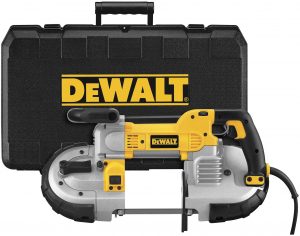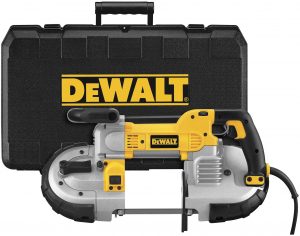Table of Contents
Introduction
When you are working with metal, there are several types of hand saw that you could choose from. On the market, you will be able to find both the manual and power hand saws available. Both the manual and power hand saws can efficiently cut through metal, but you should choose a hand saw based on the composition of the metal you intend on cutting, the size of the metal and the characteristics of the needed cut.
Just like the hand saw that would be used to cut through a thin piece of soft metal such as a steel frame or aluminium will be different from the hand saw that would be used to cut through a thick metal like steel alloy. Learning the features and capabilities of each cutting hand saw will help you make the right choice.
Handheld Circular Saw
This saw is abasic, motorized saw that is either powered by electricity or rechargeable batteries. It is able to make straight cuts through most types of metal, and some other handheld circular saws come with extra features like the ability to make angled cuts quickly. When using a handheld circular saw, it is important to choose the right blade for the metal you intend on cutting. Most circular saws accept two types of metal cutting blades.
The first metal cutting saw has an abrasive, metal cut ff discs that feature a mineral grit such as carbide. The mineral grit lines the edges of the disc, and this allows it to cut through any metalwork project. They are made to withstand the pressure that comes with cutting metal, and this makes them more durable than other regular blades.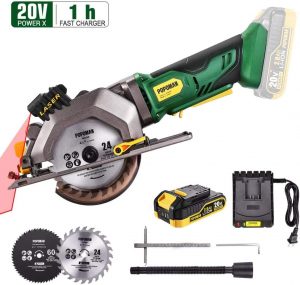
The second type of blade has a metal body, and it is constructed from high strength metals such as steel, aluminium oxide and vanadium. They have small and closely spaced teeth that are covered in a composite such as a carbide, the carbide reduces the build-up of heat and improves the blade’s efficiency.
Hack Saw
The hack saw is a manual hand saw that is common to anyone that works with metal. A hack saw has a firm, C-shaped frame that is joined to a grip handle. It has a flexible and thin blade that runs across the exposed part of the saw’s frame. The blade is supported by a front and back pin. The hack saw’s blade has varying sizes and spacing of its teeth based on its intended use.
The blades that have small and closely packed teeth give you fine cuts, and this makes them great for cutting thin and soft metals such as aluminium and copper. The blades that have large and widely spaced teeth make coarse cuts, and this makes them suitable for cutting thick metals such as iron or steel. The blade is held in place by pins, to cut through metal the user simply has to make push and pull strokes with the saw.
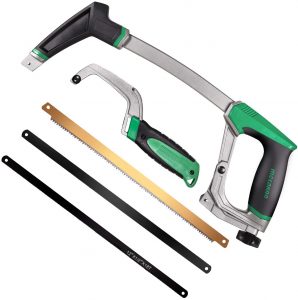
A hack saw is easy to use, but it requires patience and effort for a large scale use. There is a chance that an inexperienced user might end up with jagged edges on their workpiece, and the edges will need filling and finishing after the first cut, and this will increase your work time. Because of this, the hack saw is best suited for when you are only cutting through a limited amount of metal. However, it is a reliable tool in the hands of a professional.
Metal Chop Saw
This saw is similar to the woodworker’s miter saw in the way the blade is lowered through the material while mounted on a strong and stationary base. Metal chop saws are designed to withstand the heat, sparks, and flying debris that comes with cutting through an extensive stock, and these features makes it ideal for metal applications.
Because of the heat, spark and flying chips that comes with cutting metal, manufacturers warn users not to attach a metal cutting blade to a woodworking miter. Still, it is perfectly alright to attach a wood cutting blade to a metal cutting saw.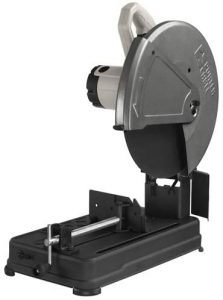
To use a metal cutting chop saw, you place the metal material on the base, under the blade and then, you turn on the spinning motion of the blade by pulling the trigger. After all that, you lower the blade through the metal material.
Reciprocating Saw
A reciprocating saw has a long, metal cutting blade that makes a back and forth sawing motion that is similar to a hacksaw. They are lightweight, which allows you to use them in any tight corner and they can quickly cut through any metal material. They are quite flexible, but their back and forth motion can make uneven cuts, and this reason is why they are mostly used for demolition jobs.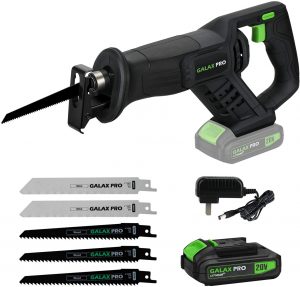
Grinder
What differentiates the grinder’s blade from other portable power saws is its unique position. Instead of it to be placed perpendicular to the tool’s motor like that of the circular saw or chop saw, the grinder’s blade is placed parallel to the motor. This lets you cut through metal by feeding the meal into the blade and making a back and forth motions. The grinder makes use of an abrasive, spinning disc as the circular saw and chop saw; this lets it quickly cut through metal.
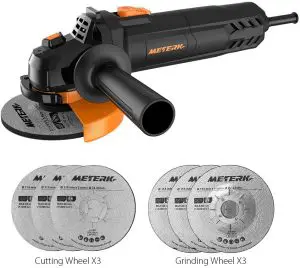 Band Saw
Band Saw
The band saw is an excellent metal cutting saw. Two rollers support the blade of the saw, and they create a fast-moving, horizontal motion that is capable of cutting through metal quickly. The band saw’s blade is similar to the blade of the hacksaw; it has small, fine teeth with small spacing that allows it to make thin cuts even through heavy and thick metals. They are easier to use than a reciprocating saw; they are great for cutting through long stock such as rebar, angle iron, pipes and steel framing and still give you a clean and burr-free cut.
Conclusion
Metal hand saws are an essential tool for anyone that works with metal; they make your work easier and faster. However, it is important to know the blade that is best suited for the metal you will be working with.

